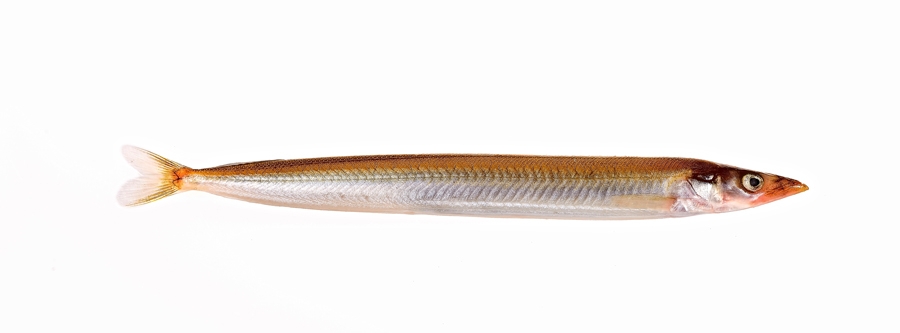The late Bill Peabody credited Rhode Island fly anger Ken Abrames with developing the tying style whose variations are known collectively as Flat-Wings. However, Bill probably did as much as anyone to popularize the style. Also, Bill’s signature rendition, the Rhody Flat-Wing, is distinct in that it uses only a single saddle hackle for the tail rather than the multiple hackles found in Abrames’ variations. In his lifetime, Bill Peabody’s work did not get the accolades that were given to some of his contemporaries. Part of the reason for this, I believe, can be attributed to Bill’s character. He was soft-spoken and unassuming, not one to call attention to himself. However, the best saltwater fly tiers of that era all knew Bill’s work and had the utmost respect for him—as did I. I can think of no more fitting tribute to Bill Peabody than to demonstrate how his influence in the world of saltwater fly tying remains strong—internationally—more than 20 years after his death. So let us introduce master fly tier Barry Ord Clarke, born and raised in the United Kingdom and now living in Norway, who is keeping Bill Peabody’s work alive for the times. I think Bill would be humbled. —George Roberts Drawing inspiration from the late Bill Peabody’s original Rhody Flat-Wing, this sand eel imitation has proven to be a very effective pattern from early summer, when sea trout begin feeding on the large shoals of sand eels that arrive along the coast of Norway. Although these native sea-run brown trout (or sea trout, as they are more commonly called) generally feed à la carte, there are a few occasions during the season when they become more selective with their feeding. One of the things I love about Flat-Wings is that they fulfill a basic set of requirements of tying and fishing larger patterns. They require only a few basic materials, which the majority of fly tiers most certainly have to hand. You can make them as simple or as complex as you wish. I’ve even tied some variations that I’ve named Saltwater Classics, which are as complicated and decorative as classic salmon flies. Although they’re light and easy to cast, even when wet, Flat-Wings give the impression of volume—not to mention the movement these patterns have…. One of the most common questions I get asked concerns the size of the hook in relation to the overall length of the fly: “Won’t the fish just bite at the tail?” You may occasionally encounter small fish that, simply because of their size, are eager but incapable. But generally speaking, most fish attack the Flat-Wing Sand Eel with great enthusiasm, ensuring solid hookups. On examining the stomach contents of many sea trout over the years, I’ve yet to find a sand eel that wasn’t swallowed head-first. This tells me that the eyes on baitfish are an important trigger and attack point. Albeit totally unscientific, I have tied the Flat-Wing Sand Eel both with and without jungle cock, and I’m under no illusion as to which takes more fish! The long, slender sand lance, more commonly known as the sand eel (family Ammodytidae), spends much of its time burrowed in the sand, especially at night and on overcast days. This indicates that it relies on good light in order to find food. Like many other bottom-dwelling fish, the sand eel has no swim bladder. It must therefore be constantly on the move—otherwise it will sink to the bottom. The first year after hatching, the sand eel is about 10 cm long (nearly 4 inches) and is almost transparent. Adult fish are a flashy silver-gold with a greenish back. Adults range from 15 cm to a huge 30 cm (6 to nearly 12 inches) in length. Here’s the YouTube video of tying the pattern: Bio: Barry Ord Clark is an angler, fly tier, and photographer of international renown. He is the author of several books on fly fishing, the most recent of which is The Feather Bender’s Flytying Techniques (Skyhorse Publishing, 2019). Barry grew up in England but now lives in Norway. Be sure to visit his fly tying website (thefeatherbender.com).
Materials
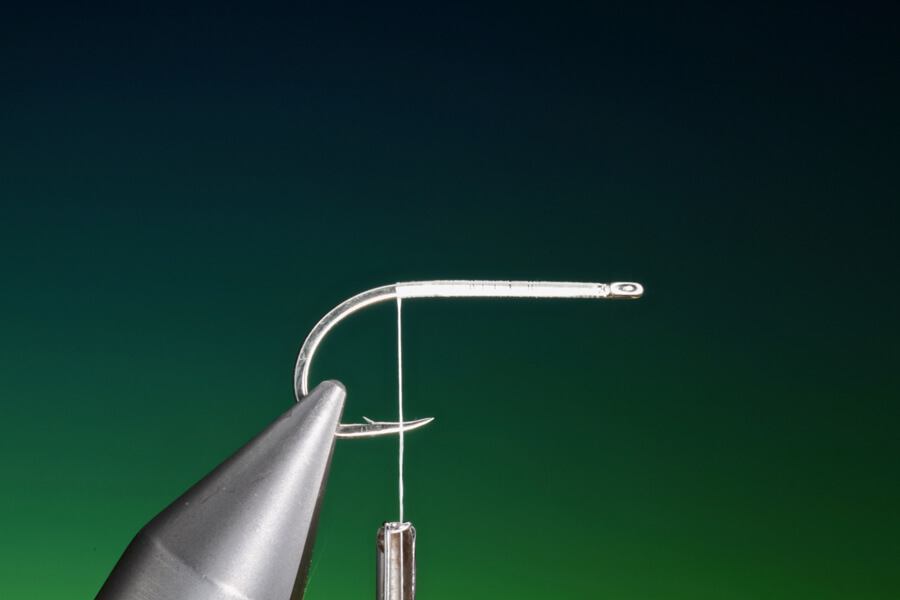 Step 1. Secure your saltwater hook in the vice as shown with the hook shank horizontal. Attach your tying thread just behind the hook eye and run a foundation over the hook shank until your thread hangs between the hook point and barb.
Step 1. Secure your saltwater hook in the vice as shown with the hook shank horizontal. Attach your tying thread just behind the hook eye and run a foundation over the hook shank until your thread hangs between the hook point and barb.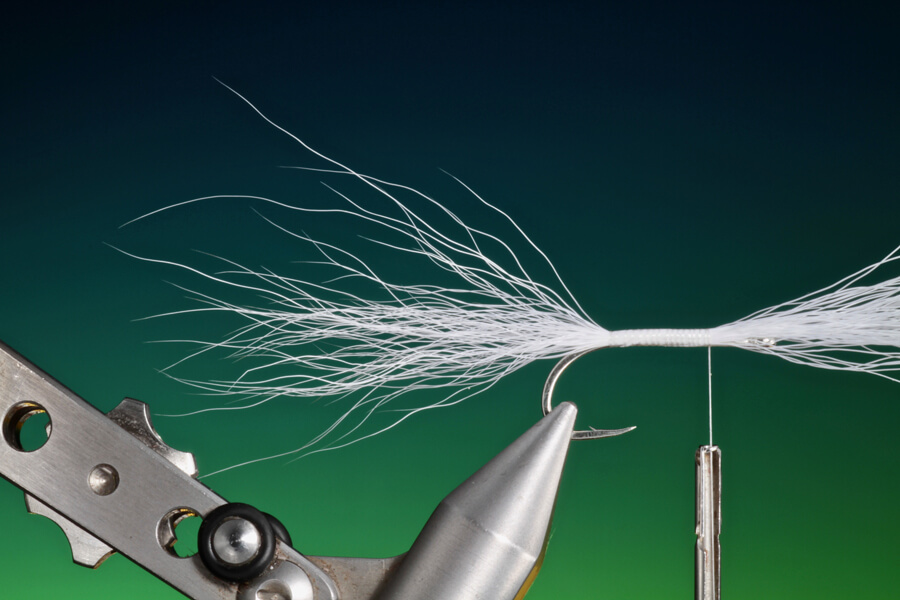 Step 2. Cut a small bunch of hair from the base of a white bucktail. Clean the bunch by removing any underfur or short hairs. Tie this in as shown so that it flares a little. Secure over the entire length of the shank.
Step 2. Cut a small bunch of hair from the base of a white bucktail. Clean the bunch by removing any underfur or short hairs. Tie this in as shown so that it flares a little. Secure over the entire length of the shank.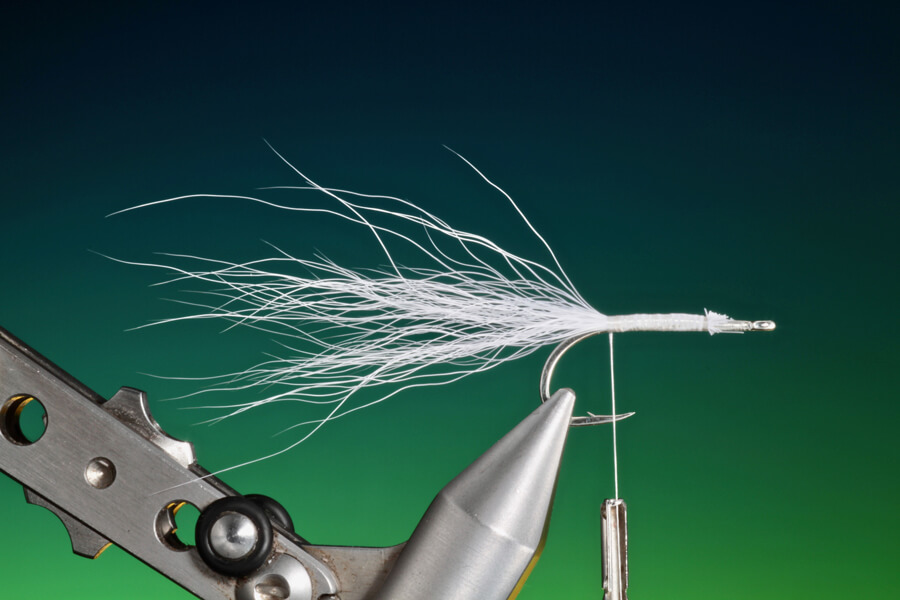 Step 3. Now make another, tighter run over the whole hook shank with tying thread to tighten the whole body, then trim away the flared surplus hair over the hook eye.
Step 3. Now make another, tighter run over the whole hook shank with tying thread to tighten the whole body, then trim away the flared surplus hair over the hook eye.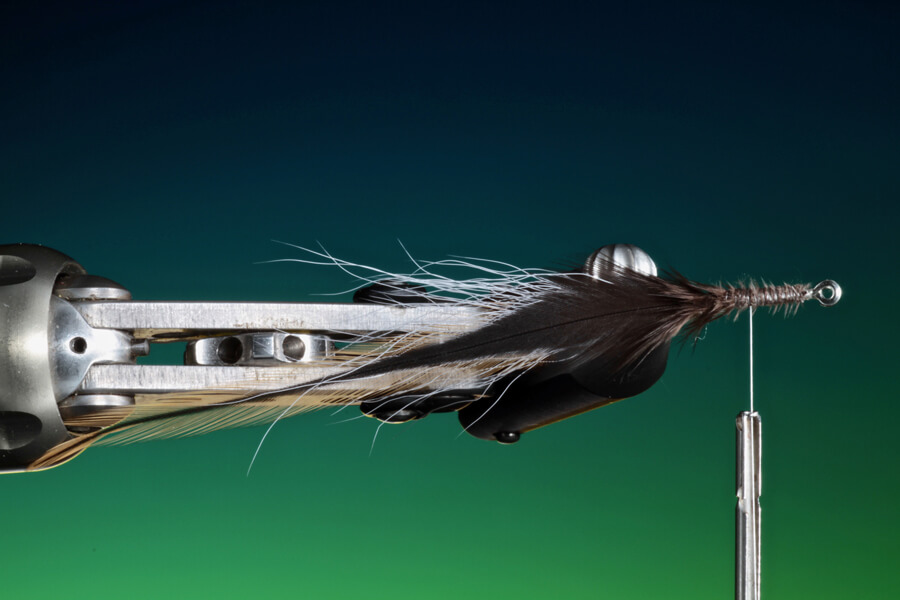 Step 4. Select a single golden badger saddle hackle for the tail. Without removing any of the downy fibers, tie in the hackle over the bucktail and directly on top of the shank. The hackle should be approximately twice the length of the bucktail.
Step 4. Select a single golden badger saddle hackle for the tail. Without removing any of the downy fibers, tie in the hackle over the bucktail and directly on top of the shank. The hackle should be approximately twice the length of the bucktail.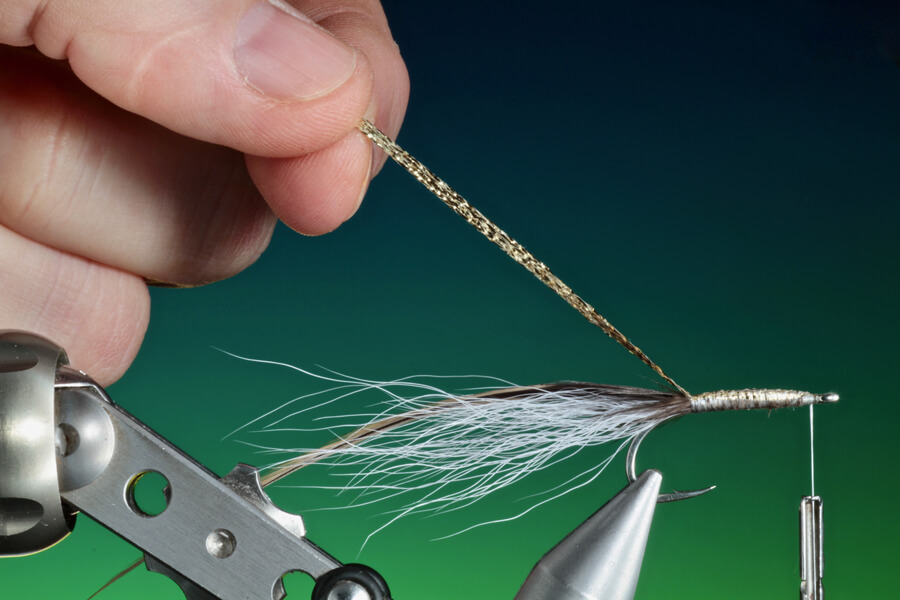 Step 5. Cut a length of your chosen Bodi-Braid and tie this in over the full length of the hook shank, finishing as shown at the tail base.
Step 5. Cut a length of your chosen Bodi-Braid and tie this in over the full length of the hook shank, finishing as shown at the tail base.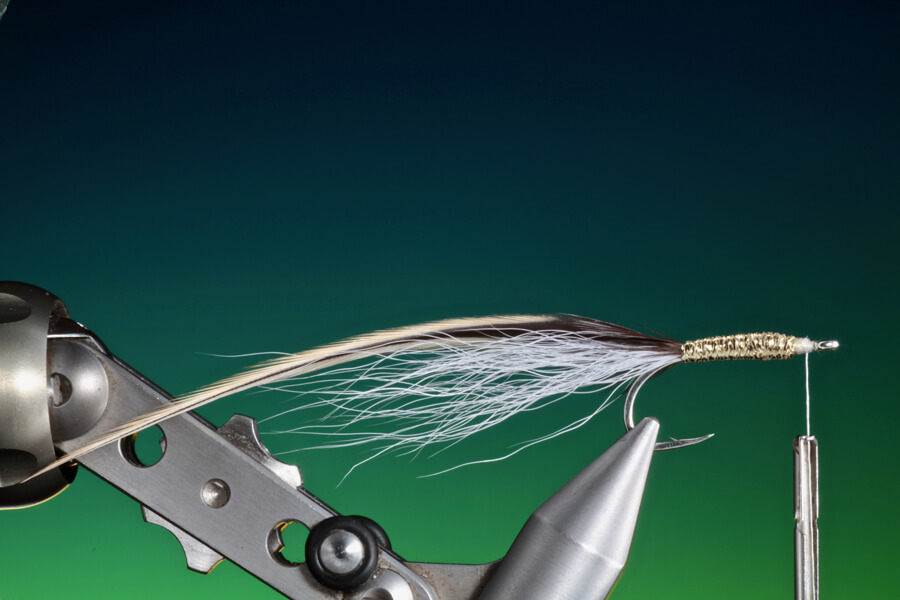 Step 6. Wrap the Bodi-Braid forward over the hook shank so that you build up a short cigar taper, finishing a short distance behind the hook eye.
Step 6. Wrap the Bodi-Braid forward over the hook shank so that you build up a short cigar taper, finishing a short distance behind the hook eye.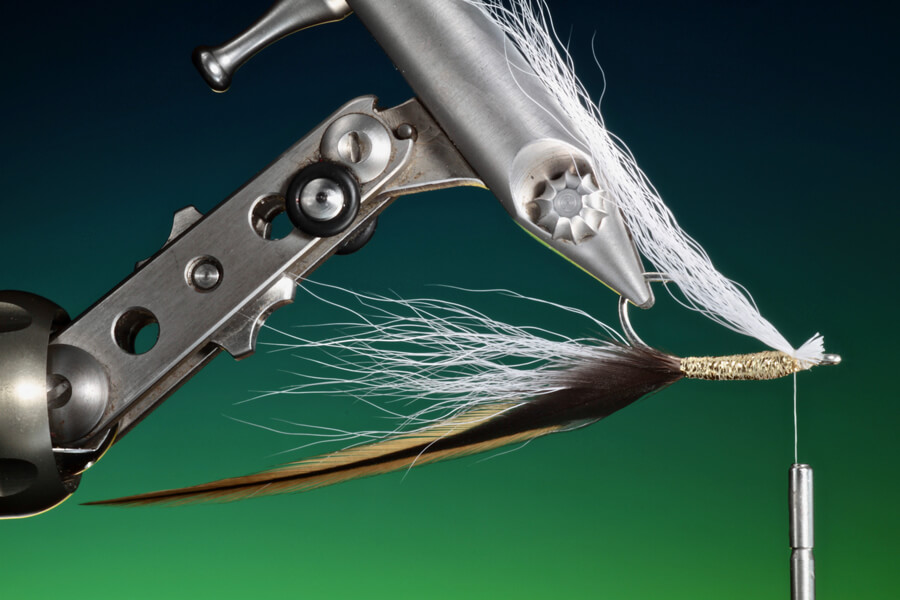 Step 7. Cut another small bunch of white bucktail, this time from the tip of the tail (the hair from the tip doesn’t flare as much as the hair from the base). Clean the bunch by removing any shorter hairs. Turn the hook upside down in the vise or rotate your vice and tie in the bucktail as a throat. This should be approximately as long as the tail hair.
Step 7. Cut another small bunch of white bucktail, this time from the tip of the tail (the hair from the tip doesn’t flare as much as the hair from the base). Clean the bunch by removing any shorter hairs. Turn the hook upside down in the vise or rotate your vice and tie in the bucktail as a throat. This should be approximately as long as the tail hair.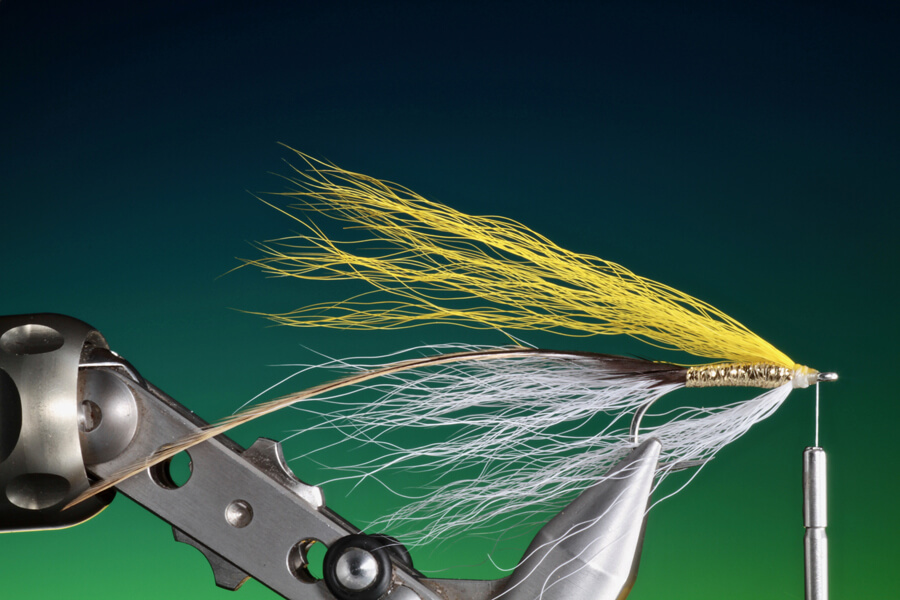 Step 8. Return your hook to its original position and tie down the trimmed ends of the throat. Next, cut a length of long straight yellow bucktail from the tip of a tail and tie this in as shown for the underwing. Take care that you don’t use too much hair; it should be just a little larger the the bunch you used for the throat.
Step 8. Return your hook to its original position and tie down the trimmed ends of the throat. Next, cut a length of long straight yellow bucktail from the tip of a tail and tie this in as shown for the underwing. Take care that you don’t use too much hair; it should be just a little larger the the bunch you used for the throat.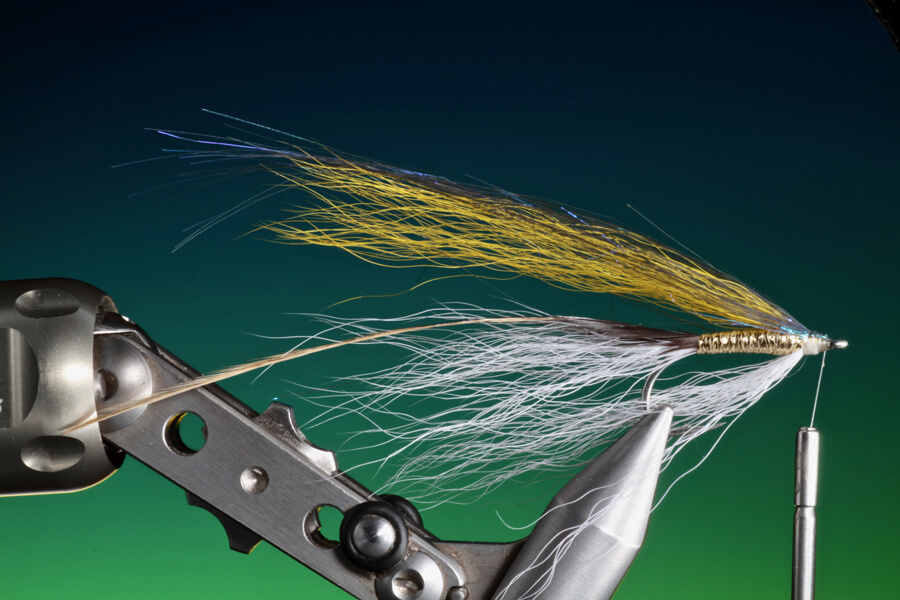 Step 9. Veniard Fringe Wing is an excellent flash material for winging medium-size saltwater patterns and is available in many colors. You’ll see the sheet of Fringe Wing is “welded” at one end. This makes it very easy to handle. Just cut a thin strip through the weld and tear off exactly the amount you need. The weld will hold all the strands in position when you’re tying it in. Lay the Fringe Wing flat on top of the yellow buck tail and secure behind the hook eye.
Step 9. Veniard Fringe Wing is an excellent flash material for winging medium-size saltwater patterns and is available in many colors. You’ll see the sheet of Fringe Wing is “welded” at one end. This makes it very easy to handle. Just cut a thin strip through the weld and tear off exactly the amount you need. The weld will hold all the strands in position when you’re tying it in. Lay the Fringe Wing flat on top of the yellow buck tail and secure behind the hook eye.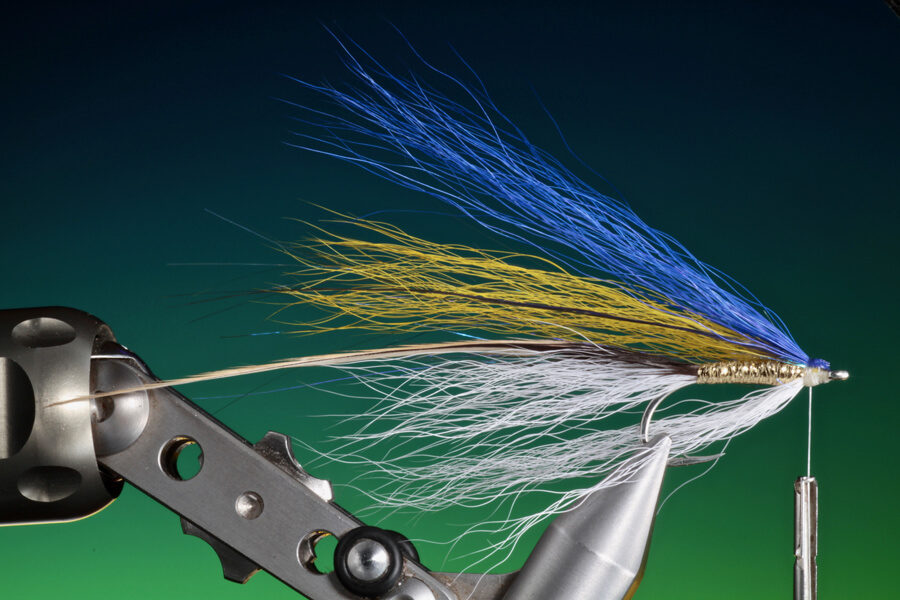 Step 10. You will now need a small bunch of blue bucktail for the overwing. Clean and tie in as with the previous yellow bunch.
Step 10. You will now need a small bunch of blue bucktail for the overwing. Clean and tie in as with the previous yellow bunch.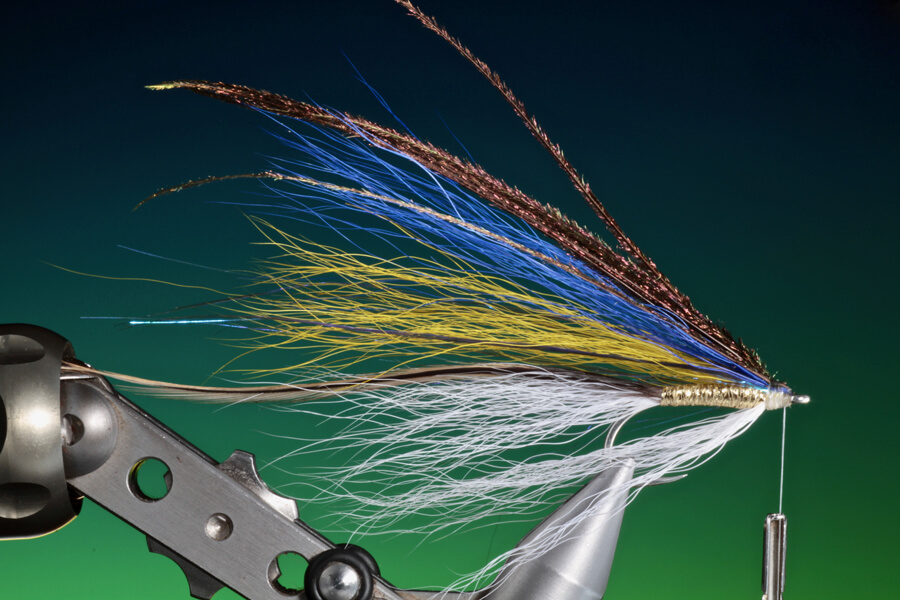 Step 11. The topping for the wing is best when you use the fibers from just under the eye of a peacock tail feather. These are a little stiffer and considerably stronger than the herl that is found lower down on the quill. Select five or six strands of herl that are a little longer than the hair wing. Tie these in directly on top of the hook shank. Once secure, trim away the surplus and tidy up the head with a few wraps of tying thread.
Step 11. The topping for the wing is best when you use the fibers from just under the eye of a peacock tail feather. These are a little stiffer and considerably stronger than the herl that is found lower down on the quill. Select five or six strands of herl that are a little longer than the hair wing. Tie these in directly on top of the hook shank. Once secure, trim away the surplus and tidy up the head with a few wraps of tying thread.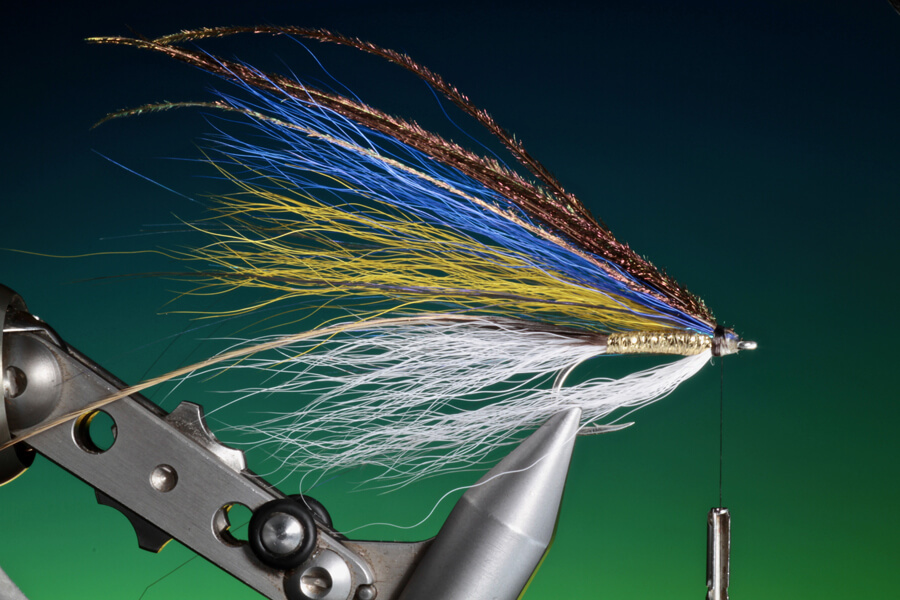 Step 12. If you are using Dyneema or GSP tying thread, use a waterproof black felt pen to color the thread black. Make a few wraps of black thread close into the wing base as shown.
Step 12. If you are using Dyneema or GSP tying thread, use a waterproof black felt pen to color the thread black. Make a few wraps of black thread close into the wing base as shown.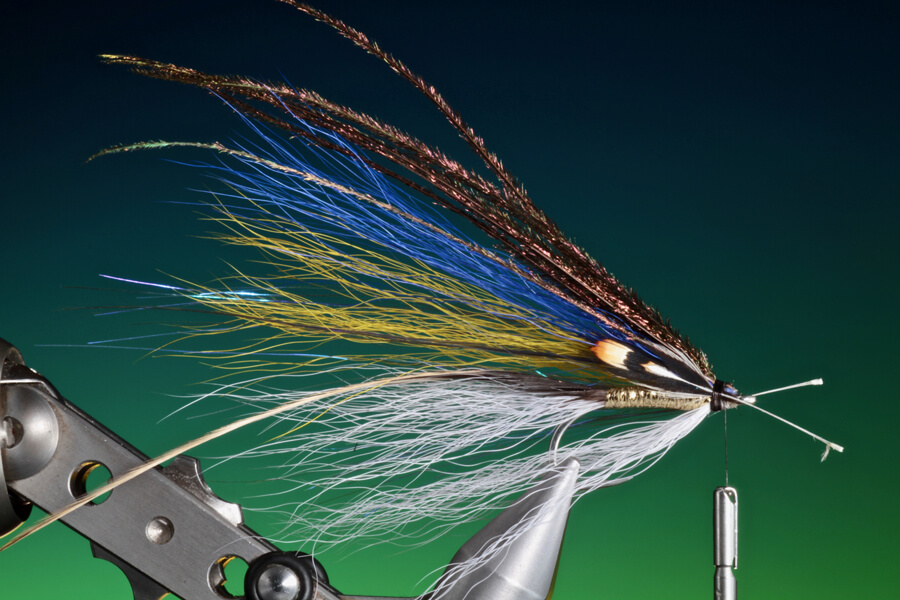 Step 13. Select two jungle cock hackles of the same size for the cheeks and tie one in at each side of the head as shown. (If you don’t have natural jungle cock, there are a number of artificial substitutes available, such as the ones manufactured by Pro.Sportfisher.)
Step 13. Select two jungle cock hackles of the same size for the cheeks and tie one in at each side of the head as shown. (If you don’t have natural jungle cock, there are a number of artificial substitutes available, such as the ones manufactured by Pro.Sportfisher.)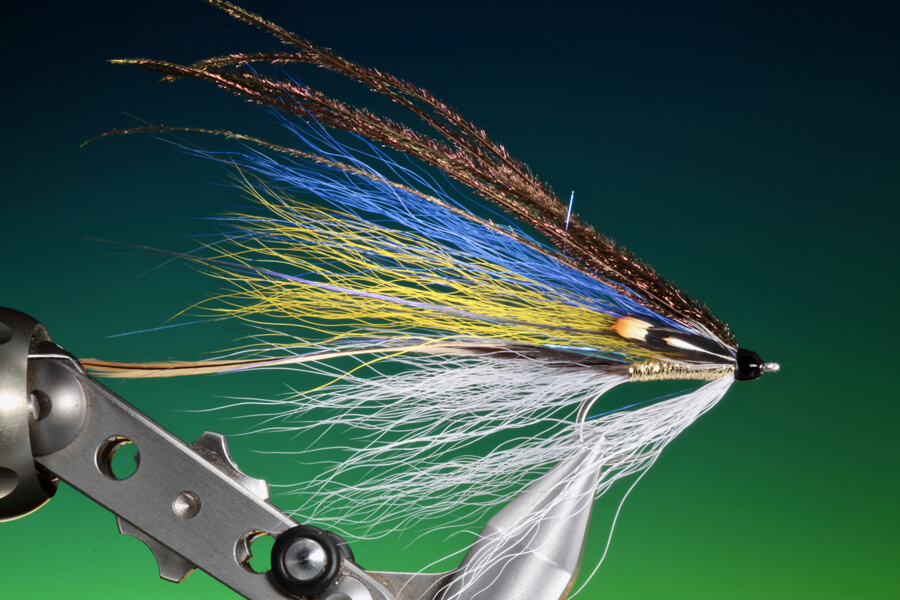 Step 14. Once the jungle cock cheeks are secure, color a little more of your thread black and cover the head with a few wraps. Whip finish and remove your tying thread. Now you can finish off the fly by giving the head two or three coats of head cement.
Step 14. Once the jungle cock cheeks are secure, color a little more of your thread black and cover the head with a few wraps. Whip finish and remove your tying thread. Now you can finish off the fly by giving the head two or three coats of head cement.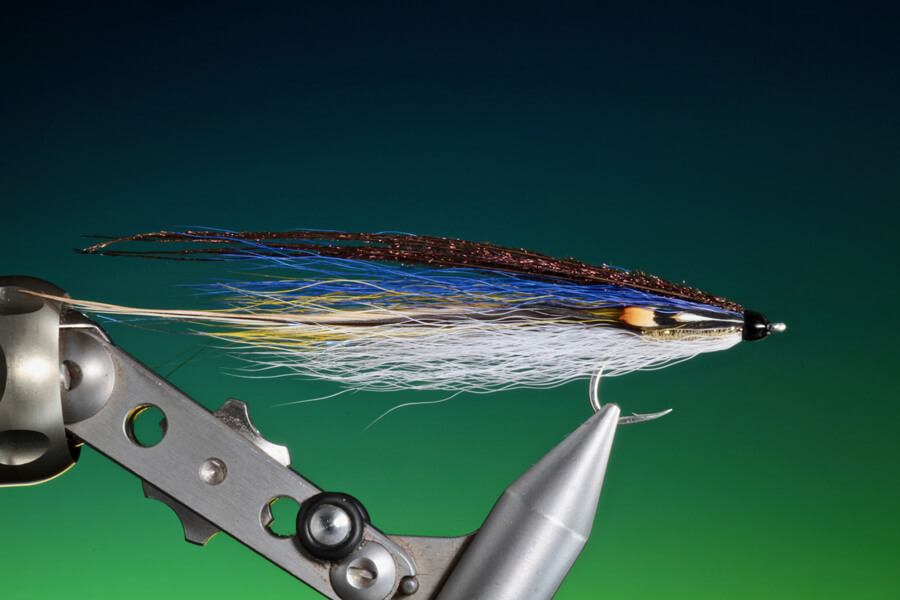 Step 15. Once the head cement has dried, remove the fly from the vise. Soak the fly in warm water and stroke the wing back and together. Then place the fly in a warm area to dry. Once dry, the wing and throat will be positioned correctly. All you need to do now is add water….
Step 15. Once the head cement has dried, remove the fly from the vise. Soak the fly in warm water and stroke the wing back and together. Then place the fly in a warm area to dry. Once dry, the wing and throat will be positioned correctly. All you need to do now is add water….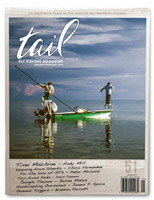 SUBSCRIBE TO TAIL FLY FISHING MAGAZINE
SUBSCRIBE TO TAIL FLY FISHING MAGAZINE

